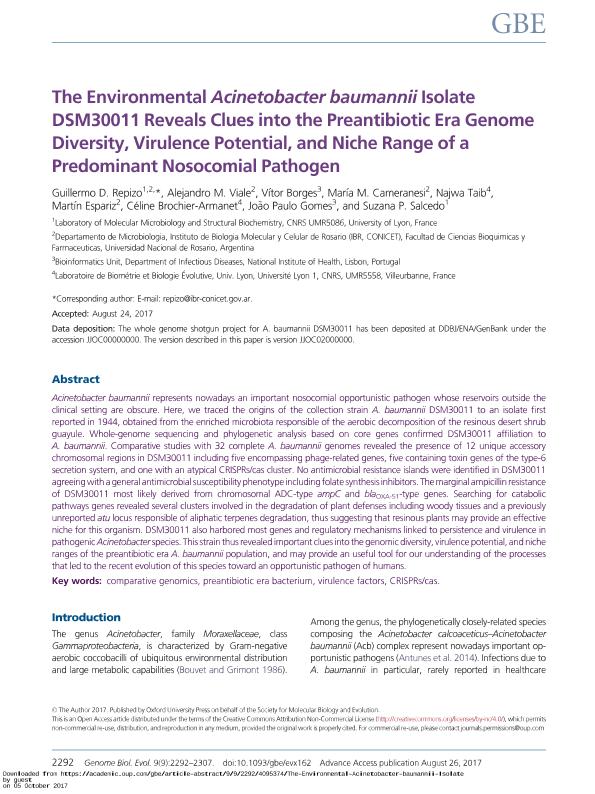Mostrar el registro sencillo del ítem
dc.contributor.author
Repizo, Guillermo Daniel

dc.contributor.author
Viale, Alejandro Miguel

dc.contributor.author
Borges, Vitor
dc.contributor.author
Cameranesi, María Marcela

dc.contributor.author
Taib, Najwa
dc.contributor.author
Espariz, Martin

dc.contributor.author
Brochier Armanet, Celine
dc.contributor.author
Gomes, João Paulo
dc.contributor.author
Salcedo, Suzana P.
dc.date.available
2019-05-06T20:18:41Z
dc.date.issued
2017-09
dc.identifier.citation
Repizo, Guillermo Daniel; Viale, Alejandro Miguel; Borges, Vitor; Cameranesi, María Marcela; Taib, Najwa; et al.; The environmental Acinetobacter baumannii isolate DSM30011 reveals clues into the preantibiotic era genome diversity, virulence potential, and niche range of a predominant nosocomial pathogen; Oxford University Press; Genome Biology and Evolution; 9; 9; 9-2017; 2292-2307
dc.identifier.issn
1759-6653
dc.identifier.uri
http://hdl.handle.net/11336/75664
dc.description.abstract
Acinetobacter baumannii represents nowadays an important nosocomial opportunistic pathogen whose reservoirs outside the clinical setting are obscure. Here, we traced the origins of the collection strain A. Baumannii DSM30011 to an isolate first reported in 1944, obtained from the enriched microbiota responsible of the aerobic decomposition of the resinous desert shrub guayule. Whole-genome sequencing and phylogenetic analysis based on core genes confirmed DSM30011 affiliation to A. Baumannii. Comparative studies with 32 complete A. Baumannii genomes revealed the presence of 12 unique accessory chromosomal regions in DSM30011 including five encompassing phage-related genes, five containing toxin genes of the type-6 secretion system, and one with an atypical CRISPRs/cas cluster. No antimicrobial resistance islands were identified in DSM30011 agreeing with a general antimicrobial susceptibility phenotype including folate synthesis inhibitors. The marginal ampicillin resistance of DSM30011 most likely derived from chromosomal ADC-type ampC and blaOXA-51-type genes. Searching for catabolic pathways genes revealed several clusters involved in the degradation of plant defenses including woody tissues and a previously unreported atu locus responsible of aliphatic terpenes degradation, thus suggesting that resinous plants may provide an effective niche for this organism. DSM30011 also harbored most genes and regulatory mechanisms linked to persistence and virulence in pathogenic Acinetobacter species. This strain thus revealed important clues into the genomic diversity, virulence potential, and niche ranges of the preantibiotic era A. Baumannii population, and may provide an useful tool for our understanding of the processes that led to the recent evolution of this species toward an opportunistic pathogen of humans.
dc.format
application/pdf
dc.language.iso
eng
dc.publisher
Oxford University Press
dc.rights
info:eu-repo/semantics/openAccess
dc.rights.uri
https://creativecommons.org/licenses/by/2.5/ar/
dc.subject
Comparative Genomics
dc.subject
Crisprs/Cas
dc.subject
Preantibiotic Era Bacterium
dc.subject
Virulence Factors
dc.subject.classification
Otras Ciencias Biológicas

dc.subject.classification
Ciencias Biológicas

dc.subject.classification
CIENCIAS NATURALES Y EXACTAS

dc.title
The environmental Acinetobacter baumannii isolate DSM30011 reveals clues into the preantibiotic era genome diversity, virulence potential, and niche range of a predominant nosocomial pathogen
dc.type
info:eu-repo/semantics/article
dc.type
info:ar-repo/semantics/artículo
dc.type
info:eu-repo/semantics/publishedVersion
dc.date.updated
2019-04-16T22:41:08Z
dc.journal.volume
9
dc.journal.number
9
dc.journal.pagination
2292-2307
dc.journal.pais
Reino Unido

dc.journal.ciudad
Oxfordshire
dc.description.fil
Fil: Repizo, Guillermo Daniel. Consejo Nacional de Investigaciones Científicas y Técnicas. Centro Científico Tecnológico Conicet - Rosario. Instituto de Biología Molecular y Celular de Rosario. Universidad Nacional de Rosario. Facultad de Ciencias Bioquímicas y Farmacéuticas. Instituto de Biología Molecular y Celular de Rosario; Argentina. Centre National de la Recherche Scientifique; Francia
dc.description.fil
Fil: Viale, Alejandro Miguel. Consejo Nacional de Investigaciones Científicas y Técnicas. Centro Científico Tecnológico Conicet - Rosario. Instituto de Biología Molecular y Celular de Rosario. Universidad Nacional de Rosario. Facultad de Ciencias Bioquímicas y Farmacéuticas. Instituto de Biología Molecular y Celular de Rosario; Argentina
dc.description.fil
Fil: Borges, Vitor. National Institute of Health. Department Of Infectious Diseases. Bioinformatics Unit; Portugal
dc.description.fil
Fil: Cameranesi, María Marcela. Consejo Nacional de Investigaciones Científicas y Técnicas. Centro Científico Tecnológico Conicet - Rosario. Instituto de Biología Molecular y Celular de Rosario. Universidad Nacional de Rosario. Facultad de Ciencias Bioquímicas y Farmacéuticas. Instituto de Biología Molecular y Celular de Rosario; Argentina
dc.description.fil
Fil: Taib, Najwa. Centre National de la Recherche Scientifique; Francia. Université Claude Bernard Lyon 1; Francia
dc.description.fil
Fil: Espariz, Martin. Consejo Nacional de Investigaciones Científicas y Técnicas. Centro Científico Tecnológico Conicet - Rosario. Instituto de Biología Molecular y Celular de Rosario. Universidad Nacional de Rosario. Facultad de Ciencias Bioquímicas y Farmacéuticas. Instituto de Biología Molecular y Celular de Rosario; Argentina
dc.description.fil
Fil: Brochier Armanet, Celine. Université Claude Bernard Lyon 1; Francia
dc.description.fil
Fil: Gomes, João Paulo. National Institute of Health. Department Of Infectious Diseases. Bioinformatics Unit; Portugal
dc.description.fil
Fil: Salcedo, Suzana P.. Centre National de la Recherche Scientifique; Francia
dc.journal.title
Genome Biology and Evolution
dc.relation.alternativeid
info:eu-repo/semantics/altIdentifier/url/https://academic.oup.com/gbe/article/9/9/2292/4095374
dc.relation.alternativeid
info:eu-repo/semantics/altIdentifier/doi/http://dx.doi.org/10.1093/gbe/evx162
Archivos asociados
